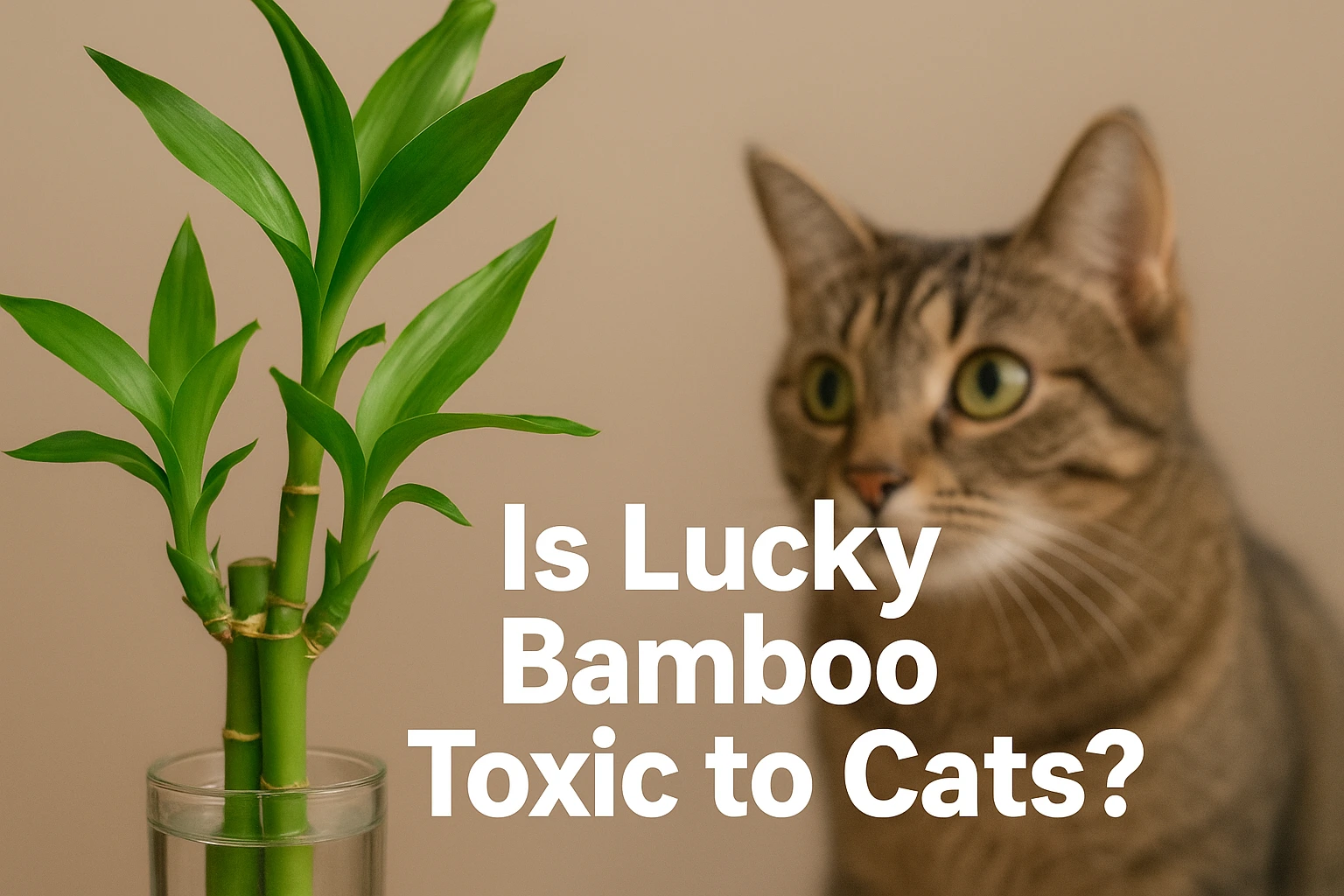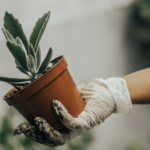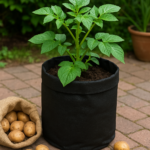As cat owners, we always want to make sure our homes are safe, comfortable, and welcoming for our furry friends. Plants often bring beauty and positive energy to our space, but not all greenery is cat-safe. One plant that often confuses is lucky bamboo. It’s stylish, easy to care for, and believed to bring good fortune, making it a popular choice for many households. However, what most pet parents don’t realize is that lucky bamboo can pose a health risk to cats.
Knowing whether a plant is safe is crucial because cats are naturally curious creatures, often chewing on leaves or playing with stems. In this article, we’ll explore what lucky bamboo is, why it can be dangerous, symptoms of poisoning, what to do if your cat eats it, and safe alternatives you can keep instead. Let’s dive into everything you need to know about lucky bamboo and cats.
What Is Lucky Bamboo?

Despite its name, lucky bamboo is not actually bamboo at all. Its scientific name is Dracaena sanderiana, and it belongs to the Dracaena family rather than the bamboo family. Native to Africa, lucky bamboo has become a global favorite, particularly in Asia, where it’s often associated with good luck, prosperity, and harmony in Feng Shui practices. Its unique stalks can be trained into spirals, braids, or other decorative shapes, making it a popular gift for new homes and offices.
Lucky bamboo is hardy and thrives in water or soil with minimal care, which adds to its popularity. Many households place it in water-filled vases with pebbles, believing it attracts positive energy. However, this easy-to-grow houseplant carries risks for pets. Unlike true bamboo, which is safe for cats, lucky bamboo contains toxic compounds that can harm your feline companion if chewed or ingested. Understanding this difference is critical for cat owners who want both greenery and pet safety.
Difference Between True Bamboo and Lucky Bamboo
It’s easy to assume that lucky bamboo is just another form of bamboo, but that assumption can put cats at risk. True bamboo belongs to the grass family (Poaceae) and is non-toxic to cats. It can grow into towering stalks and is often used for building, furniture, and even as a food source for animals like pandas. Cats can chew on true bamboo leaves without facing harmful effects.
Lucky bamboo, however, belongs to the Dracaena genus, which is known to contain toxins harmful to pets. The confusion arises because lucky bamboo looks very similar to real bamboo. Both have tall green stalks and leaves, but the internal composition is completely different. This misidentification often leads cat owners to unknowingly introduce toxic plants into their homes. Knowing the difference can protect your pet from unnecessary health risks. If you’re shopping for bamboo plants, always double-check the species name to ensure you’re bringing home the safe, non-toxic kind.
Is Lucky Bamboo Really Toxic to Cats?
Yes—lucky bamboo is toxic to cats. According to the ASPCA (American Society for the Prevention of Cruelty to Animals), lucky bamboo contains chemical compounds that can upset a cat’s digestive system and, in severe cases, cause more serious health issues. When a cat chews or bites into the leaves or stalks, these compounds are released, leading to poisoning symptoms.
Cats are naturally curious and tend to chew on houseplants out of boredom, hunger, or playfulness. This makes it even more important for owners to know which plants are unsafe. While lucky bamboo may not always cause life-threatening symptoms, it can definitely make your cat very uncomfortable. In some cases, veterinary intervention is needed to prevent complications. The toxicity level depends on how much of the plant the cat consumes, making prevention the safest approach. If you keep lucky bamboo at home, it’s best to place it well out of reach—or better yet, avoid it altogether.
Why Is Lucky Bamboo Toxic to Cats?

The main reason lucky bamboo is toxic lies in its chemical composition. The plant contains saponins, natural compounds that act as a defense mechanism for the plant. While saponins don’t usually harm humans in small doses, they are dangerous for pets, especially cats. When ingested, saponins can irritate a cat’s stomach and digestive tract, leading to vomiting, drooling, and loss of appetite.
In larger amounts, these toxins can cause more severe symptoms like tremors, weakness, or difficulty coordinating movements. Cats are more sensitive than dogs to certain plant toxins, making it essential to avoid any unnecessary exposure. Even chewing on the leaves without fully swallowing them can release enough sap to trigger symptoms. Understanding the science behind this toxicity can help cat owners see why lucky bamboo isn’t worth the risk. If you’re looking for greenery, there are many safe alternatives that provide beauty without endangering your cat’s health.
Symptoms of Lucky Bamboo Poisoning in Cats
If your cat has chewed or ingested lucky bamboo, you may notice signs of poisoning within a few hours. The symptoms depend on how much of the plant was eaten and the cat’s overall health. Common symptoms include vomiting, drooling, lack of appetite, lethargy, and weakness. These are your first warning signs that something is wrong.
In some cases, cats may show changes in behavior, such as hiding more than usual or avoiding food. Because cats are skilled at masking discomfort, even mild symptoms should not be ignored. If the poisoning is more severe, your cat may experience tremors, dilated pupils, or trouble balancing. Recognizing these signs early is key to preventing serious health issues. Always monitor your cat closely if you suspect exposure and be ready to contact your veterinarian. The sooner treatment begins, the better the recovery outcome.
Mild Symptoms to Watch For
When a cat has only chewed on a small portion of lucky bamboo, the symptoms may remain mild but still noticeable. The most common early signs include drooling, slight vomiting, and reduced appetite. Your cat may lick its lips frequently or paw at its mouth due to the irritation caused by the saponins. Some cats also become restless or start drinking more water than usual. While these symptoms may not appear alarming at first, they should never be ignored. Even mild cases can quickly worsen if more of the plant is consumed. Monitoring your cat’s behavior closely after exposure is crucial. If your feline friend continues eating normally within a few hours and symptoms fade, it’s possible the irritation was minimal. However, it’s always a good idea to call your vet, describe what happened, and ask if an examination is needed. Remember—early intervention often prevents bigger health problems.
Severe Symptoms of Poisoning
If a cat consumes a larger portion of lucky bamboo, the effects can escalate into serious and sometimes life-threatening symptoms. Severe vomiting, diarrhea, and dehydration are common when significant amounts are ingested. Cats may also show neurological issues such as tremors, seizures, dilated pupils, or loss of coordination. These signs indicate that the toxins have started to affect the nervous system, making immediate veterinary attention essential. Another worrying symptom is extreme lethargy, where the cat refuses to move or interact. In some cases, difficulty breathing or irregular heartbeat may also develop. If you notice any of these severe signs, don’t wait—rush your cat to the vet or an emergency pet clinic. The faster treatment is provided, the higher the chances of recovery. Severe poisoning is rare but dangerous, which is why prevention and quick action are so important when dealing with toxic plants like lucky bamboo.
What To Do If Your Cat Eats Lucky Bamboo?
Discovering your cat nibbling on lucky bamboo can be stressful, but knowing the right steps can make a huge difference. First, remove any plant material from your cat’s mouth gently and safely. Next, rinse your cat’s mouth with fresh water if possible, as this helps reduce irritation. Do not attempt to induce vomiting unless your veterinarian specifically advises it—doing so incorrectly can cause more harm. Immediately call your vet or an emergency animal poison hotline to explain what happened, how much was eaten, and what symptoms you’ve observed. Follow their guidance carefully. In the meantime, keep your cat calm and provide fresh water. If the vet recommends bringing your cat in, take the plant (or a photo of it) with you to help confirm identification. Quick action, honesty about the situation, and professional care are the best ways to ensure your pet’s safety.
How Vets Treat Lucky Bamboo Poisoning in Cats
When you take your cat to the vet after exposure to lucky bamboo, treatment depends on how much was ingested and the severity of the symptoms. In many cases, vets may start with inducing vomiting or administering activated charcoal to prevent further toxin absorption. Intravenous (IV) fluids are often given to manage dehydration, especially if the cat has been vomiting repeatedly. Medication may also be used to control nausea, protect the stomach lining, and stabilize any tremors or seizures. Hospitalization could be necessary for severe cases, allowing vets to monitor organ function and provide supportive care. The good news is that with timely treatment, most cats recover fully from lucky bamboo poisoning. However, delayed treatment can lead to complications. This is why contacting a veterinarian right away is so important—even if the symptoms seem mild at first. A professional evaluation ensures your cat gets the care it needs.
Safe Alternatives to Lucky Bamboo for Cat Owners
If you love the look of greenery in your home but want to keep your cat safe, there are many cat-friendly plants that make excellent alternatives to lucky bamboo. Some great options include spider plants, Boston ferns, areca palms, and parlor palms. These plants are non-toxic, attractive, and add a fresh touch to your home decor without putting your pet at risk. Another fun choice is cat grass or catnip, which not only are safe but also provide enrichment and enjoyment for your feline friend. Switching to safe alternatives allows you to enjoy the beauty of indoor plants while ensuring peace of mind. Before buying any new plant, always check if it’s listed as toxic or non-toxic by trusted sources like the ASPCA. Choosing safe plants is an easy step that protects your cat’s health while still letting you enjoy a lively, green environment at home.
Preventing Accidental Ingestion
Prevention is always better than cure, especially when it comes to toxic plants and curious cats. One of the simplest strategies is to avoid bringing toxic plants into your home altogether. If you already have lucky bamboo, place it in an area that’s completely inaccessible to your cat—though keep in mind that cats are skilled climbers and jumpers, so “out of reach” isn’t always truly safe. Consider using hanging planters or closed terrariums to reduce temptation. Providing your cat with safe alternatives like cat grass or catnip can also redirect their curiosity. Keeping your cat mentally and physically stimulated through toys and playtime helps reduce boredom chewing. Additionally, learn to recognize toxic plant species and label your plants so family members or visitors don’t accidentally place them within reach. Creating a safe indoor environment ensures both you and your cat can enjoy greenery without constant worry.
Common Myths About Cats and Lucky Bamboo
There are several myths surrounding cats and plants that can put pets at risk. One common myth is that “cats instinctively know which plants are toxic and will avoid them.” In reality, many cats chew on plants out of boredom or curiosity, regardless of toxicity. Another myth is that “lucky bamboo is safe because it looks like real bamboo.” This misconception leads many owners to believe it poses no harm, but the truth is lucky bamboo is toxic while true bamboo is not. Some also believe that keeping plants in high places makes them safe, forgetting that cats are skilled climbers. Relying on these myths instead of facts can endanger your cat’s health. The best protection comes from accurate information and proactive prevention. As pet parents, we can’t depend on instinct or appearance alone—we need to research and ensure our homes are truly safe for our furry companions.
Indoor Plants Commonly Mistaken as Cat-Safe but Toxic
Lucky bamboo isn’t the only plant that can surprise pet owners with hidden dangers. Several common indoor plants look harmless but are toxic to cats. Lilies are among the most dangerous, as even a small amount can cause kidney failure in cats. Aloe vera, often praised for its healing properties in humans, contains compounds that are harmful to felines. Pothos, another popular decorative plant, can irritate a cat’s mouth and digestive tract if chewed. Even seemingly safe decorative plants like peace lilies and philodendrons are toxic. Because many of these plants are easy to find in homes and offices, cat owners must be extra cautious. Always double-check before adding new greenery indoors. A simple online search or reference to the ASPCA’s toxic plant list can help you avoid accidents. By being informed, you can create a stylish home full of plants without compromising your cat’s safety.
Conclusion
Lucky bamboo may bring beauty and symbolism of good fortune, but it carries hidden risks for cats. The plant contains saponins, which can cause symptoms ranging from mild drooling and vomiting to severe tremors and seizures. While fatalities are rare with prompt treatment, the discomfort and potential danger make this plant unsuitable for cat households. As cat owners, our responsibility is to balance our love for greenery with our pets’ safety. Thankfully, many safe alternatives exist, such as spider plants, ferns, and palms, which bring life to our homes without risk. Ultimately, the best choice is prevention: avoid toxic plants, keep emergency vet contacts handy, and create a cat-friendly environment. Your home can still thrive with plants while ensuring your feline friend stays healthy, happy, and safe. In the end, luck isn’t found in a bamboo stalk—it’s in the love and well-being of your cat.
FAQs
1. Can cats die from eating lucky bamboo?
Yes, while death is rare, it is possible if a cat consumes a large amount of lucky bamboo and treatment is delayed. The toxins can lead to severe dehydration, seizures, and organ issues if not addressed quickly.
2. How much is lucky bamboo dangerous for cats?
Even small amounts can cause mild symptoms like vomiting and drooling. Larger quantities pose a more serious risk, so any ingestion should be treated seriously and checked by a vet.
3. What should I do if my cat only chewed a leaf?
Even a single leaf can irritate. Remove plant remnants from your cat’s mouth, monitor symptoms, and call your vet to be safe.
4. Is lucky bamboo safe for dogs, too?
No, lucky bamboo is toxic to dogs as well. The same saponins that harm cats can cause vomiting, weakness, and other symptoms in dogs.
5. How do I make my home safe for cats and plants?
Choose cat-safe plants like spider plants, Boston ferns, or cat grass. Keep any questionable plants out of reach, provide cat toys for enrichment, and always check toxicity lists before bringing new greenery home.







